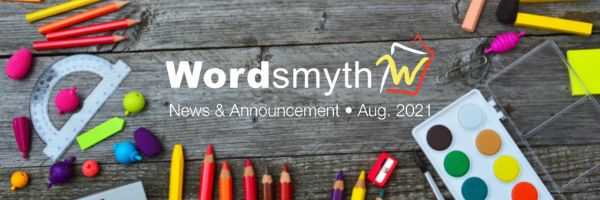
Get your Teacher Tools ready for the new school year!
As schools are set to begin this new year, Wordsmyth invites you to try out the beta version of our new Teacher Tools. It’s easy to set up. With the Teacher Tools, you can manage your students and classes, give vocabulary assignments, and receive reports on student vocabulary growth.
As you use the Teacher Tools, please share with us your experience and feedback. We hope to release the official version of Teacher Tools next year. With your help, the new version will provide a better user experience for you and your students. Thank you in advance!
First 1000 words for beginning learners–Introducing WILD Word Learner
Wordsmyth is proud to announce a new app, WILD Word Learner, for young learners K to 2. This is the first app in a series of vocabulary game apps for beginning learners. With close to 1000 carefully selected words in total, users can play games matching the sound of a word with its image. The next in the series calls for matching a spelled word with its image, and the third app calls for matching a word’s sound with its spelling. The app is free and comes loaded with a generous number of free wordlists. Additional wordlists that are purchased can be used in all game apps in the WILD Word Learner series.
The app is a companion to the Wordsmyth Illustrated Learner’s Dictionary (WILD), but it is not a replacement, as WILD contains a great many more words and features. Please subscribe to Wordsmyth to fully utilize the rich content in WILD, as well as to take advantage of our general subscriber features.
WILD for PreK-2 Vocabulary learning
The Wordsmyth Illustrated Learner’s Dictionary (WILD) is organized into four sections that facilitate children’s vocabulary learning in two ways: (a) learning new words for concepts the child already has, and (b) learning new concepts and new words that add new ways of organizing the child’s thinking. During the crucial early years, this process changes children’s understanding of how meanings work — their concept of definition. WILD’s unique organization reflects the challenges involved in these changes and provides the resources a child needs to move among the new words and new concepts. Each component of WILD focuses on a particular type of word and concept learning. The components of WILD — and the word learning focus for each of them — are:
- PICTURE DICTIONARY: for word-object naming;
- WORLD: for thematic relations among things in their usual environments;
- COLLECTIONS: for topical relations (“loose categories”) and taxonomic categories;
- BOOK: for an alphabetical organization of words, outside of their connections with the world.

